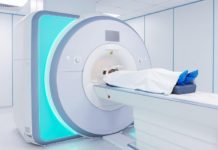InSightec Ltd. today announced that three new papers published in the November issue of Ultrasound in Obstetrics and Gynecology add to the growing body of data supporting the use of ExAblate as a safe, effective and durable treatment for uterine fibroids.
Non-Invasive Uterine Fibroid Treatment with ExAblate Shows Significantly Fewer Complications and Faster Recovery than Hysterectomy
InSightec Ltd. today announced that three new papers published in the November issue of Ultrasound in Obstetrics and Gynecology add to the growing body of data supporting the use of ExAblate as a safe, effective and durable treatment for uterine fibroids.
One study showed that non-invasive treatment with the ExAblate Magnetic Resonance-guided Focused Ultrasound (MRgFUS) system offers women a significantly less risky treatment for symptomatic uterine fibroids with much faster recovery time than hysterectomy. A separate study shows the positive correlation in the volume reduction of the fibroid to symptom improvement after two years, while a third showed improvement in outcomes of ExAblate treatments as physicians improved their skills with the system.
“Our understanding of how to apply this new technology in the treatment of uterine fibroids has been rapidly expanding,” wrote Prof. Wladyslaw M. Gedroyc, St. Mary’s Hospital, Imperial College Healthcare Trust, London, UK, in an Opinion published in the November issue. “We now know that MRgFUS works quickly with very few side effects and that patients can return to normal function almost immediately after treatment. We also know that the larger the area of ablation that can be produced in the targeted fibroids, the better the symptomatic response and the less the need for other fibroid interventions, and that when the early symptomatic response is highly effective, long-term improvement of symptoms is almost invariably seen,”
A prospective study of 192 patients at 14 different medical centers across the United States, Israel, the United Kingdom and Germany, showed that MRgFUS was associated with significantly fewer adverse events in comparison with hysterectomy patients. Similarly, recovery times were much faster for MRgFUS, with an average of only one day away from work as opposed to 6 weeks for hysterectomy
In a separate retrospective multi-center study of patients who had undergone MRgFUS in Japan, researchers found that as practitioners gained more experience using MRgFUS, their treatments were increasingly effective and that the percentage of patients that who required a second treatment at one year decreased significantly, from 12% in the first group to 5% in the patients treated later. These numbers are similar to the retreatment rates of other uterine-conserving solutions.
Another Japanese study, from Shinsuma Hospital, showed that different types of fibroids respond differently to MRgFUS. Low-intensity T2 signal fibroids respond extremely well, with large areas of destruction being easily produced which lead to large Non-Perfused Volumes (NPVs). In comparison, fibroids of high intensity T2 signal do not respond as well to MRgFUS. As a result, at 12 months only 2.9% of the patients treated with low intensity fibroids required retreatment and 14% at 24 months, compared to 22% at 24 months for high intensity group.
Over 5,000 patients worldwide have already benefited from the ExAblate treatment which is the only U.S. Food and Drug Administration (FDA)-approved system to use the breakthrough MRgFUS technology that combines MRI — to visualize tissues in the body, plan the treatment and monitor, in real time, treatment outcome — and high intensity focused ultrasound to thermally ablate tissue. MR thermal feedback, provided uniquely by the system, allows the physician to control and adjust the treatment in real time to ensure that the targeted tumor is fully treated and surrounding tissue is spared. ExAblate received the CE Mark for uterine fibroids in October 2002 and FDA approval for the treatment of symptomatic uterine fibroids in October 2004.
“The non-invasiveness of the MRgFUS procedure and its ability to rapidly restore patients to an improved function are very strong advantages and the conversion of hospital inpatient stays into outpatient procedures is very attractive economically given the rapid gain in quality of life post-therapy, with few complications,” Dr. Gedroyc concluded in the editorial.
About Uterine Fibroids
Uterine fibroids are benign growths in the uterus that affect one in four women of childbearing age. Uterine fibroids can cause heavy bleeding that leads to anemia, bloating, abdominal pain, and other symptoms. Each year hundreds of thousands of women worldwide have hysterectomies to treat uterine fibroids. Unlike hysterectomy, myomectomy and UAE, ExAblate is completely non-invasive, using MR guided focused ultrasound to thermally ablate (destroy) growths in the uterus. For women this means no hospital stay and only one to two days of recovery as opposed to one week (UAE); two weeks (myomectomy); or six weeks (hysterectomy) usually associated with treatment of this condition.
About ExAblate®
ExAblate is the first system to use the MR guided focused ultrasound technology that combines MRI – to visualize the body anatomy, plan the treatment and monitor treatment outcome in real time – and high intensity focused ultrasound to thermally ablate tumors inside the body non-invasively. MR thermometry, provided uniquely by the system, allows the physician to control and adjust the treatment in real time to ensure that the targeted tumor is fully treated and surrounding tissue is spared. The ExAblate system was approved by the U.S. Food and Drug Administration in 2004 as a treatment for symptomatic uterine fibroids. Over 5,000 women have been treated worldwide to date. ExAblate® 2000 received the European CE Mark for pain palliation of bone metastases in June 2007.
About InSightec
InSightec Ltd. is a privately-held company owned by Elbit Imaging, General Electric, MediTech Advisors, LLC and employees. It was founded in 1999 to develop the breakthrough MR guided Focused Ultrasound technology and transform it into the next generation operating room. Headquartered near Haifa, Israel, the company has over 160 employees and has invested more than $120 million in research, development, and clinical investigations. Its U.S. headquarters are located in Dallas, Texas. For more information, please go to: http://www.insightec.com /
Media Contact:
Hollister Hovey
Lazar Partners
646-871-8482
hhovey@lazarpartners.com























